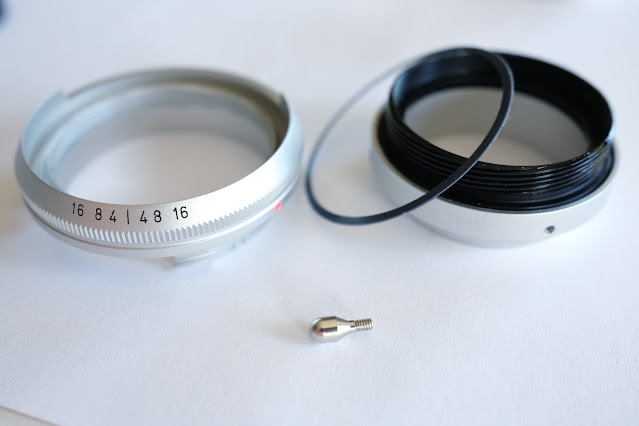MS Optical lenses are well known for their unique compactness, interesting rendering and practical minimalistic design. The model I'm going to explore more in this article is a MS-Optics Apollon 36mm F1.3 lens in Leica M mount. Big thanks to Fred Miranda for landing his lens, and additionally for his own effort and knowledge sharing on initial disassembly explorations which made this discovery process easier.
Intro
Lens is extremely compact, which is typically achieved by reducing a number of moving mechanics and transmission rings. MS-Optics Apollon 36mm F1.3 indeed has only three moving sections, similar to Voigtlander 40mm F2.8 lens - mount frame, focusing core and aperture ring. I don't count here aperture blades assembly module, which is anyway complex assembly in any lens.
Extracting Lens Core
Optical core is built as a single unit, which can be released by unscrewing CCW retention ring. Fred discovered earlier that overtightening this retention ring will make aperture ring rotation too stiff, and soon you will see why.
This is how aperure control is simplified in MS-Optics Apollon lens - whole optical core frame is acting as aperture ring. When rotated inside focusing frame, aperture transmission bolt remains at same inner groove of focus ring, which is making aperture module to close/open blades.
Fred also discovered that rear module of optical core can be unscrewed CCW, which provides access to the aperture chamber and inner lens surfaces for cleaning.
Dismounting RF couple ring
This part of disassembly is extremely hard, due to MS Optical decision to secure RF couple ring on focusing core with strong glue. Fred tried to unscrew it using spanner wrench but RF ring did not move, glue is holding micro-thread too strong. Then we decided to give it a try by myself, using some advanced methods.
First of all I'm unscrewing CCW focusing pin.
Dismount focusing core
With RF couple ring removed, focus ring can travel further until focus pin location is reaching first "8" of DOF scale . This is the point where focus thread is detaching.
At this point focusing thread can be cleaned and greased if you need to. I'm going to assemble lens back in a reverse order.
Note - aperture transmission silver bolt should fit into vertical groove on the inner wall of focusing frame.
Cleaning and recovering RF couple ring
Here is a closeup of micro-thread on RF couple ring, after complete cleaning out securing glue.
Assembling and tuning RF couple precision
The optical core is inserted into focusing core and next step is to add and tighten the retention ring in CW direction.
At this point RF couple ring radial position can be easily tuned to align camera RF indication. Once precise RF position found, mark it using pencil. Later you will need to secure RF ring by adding a little amount of loctite glue to one tiny spot of micro-thread. Don't add too much, to keep disassembly easier.
Conclusions
MS-Optics Apollon 36mm F1.3 lens disassembly was quite a challenge. Main problem is over excessive amount of glue used to secure RF couple ring, making it also impossible to fine tune RF precision
Though physically possible but quite hard, Apollon can be refined through explored maintenance steps to bring it to adjustable shape. I'll let Fred continue with RF precision calibration, he already had great success with calibrating MS-Optics Petz model by tweaking radial position of RF couple ring. Now Apollon 36mm F1.3 lens can follow similar DIY calibration pattern and became one of the rarest copies well tuned for precise Leica rangefinder use.




















